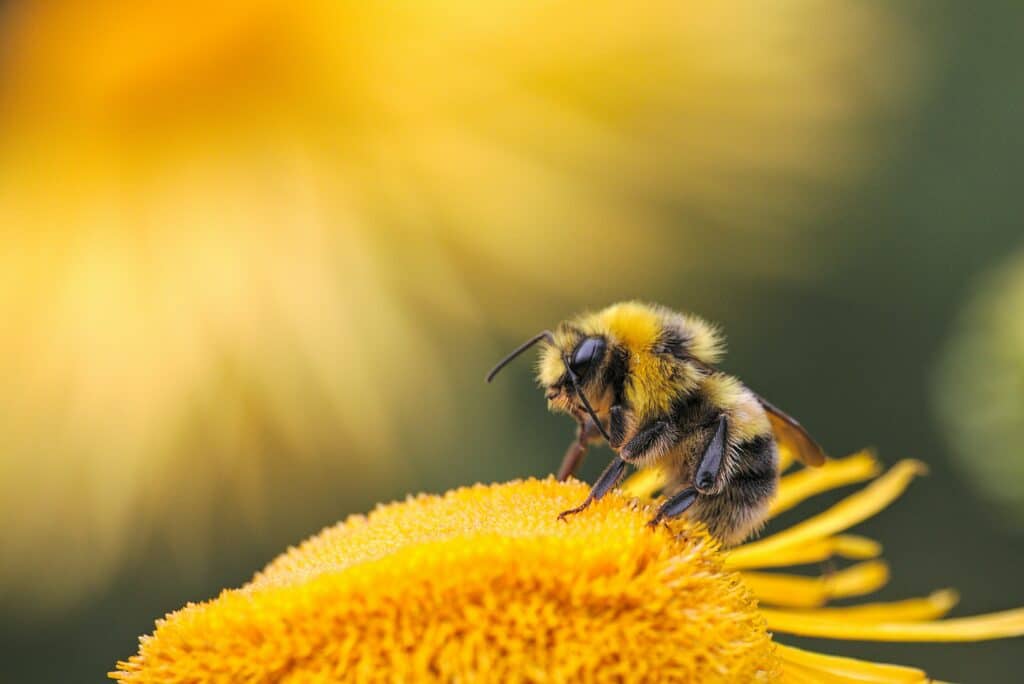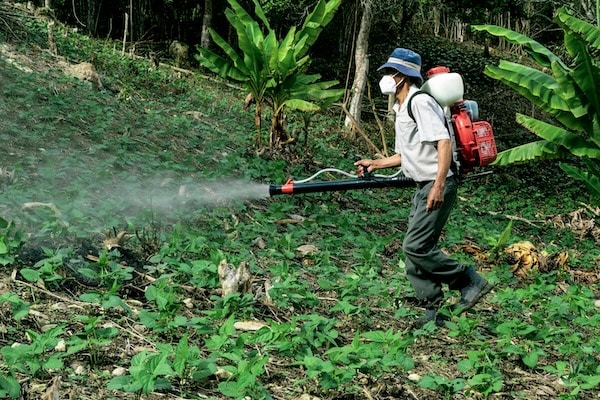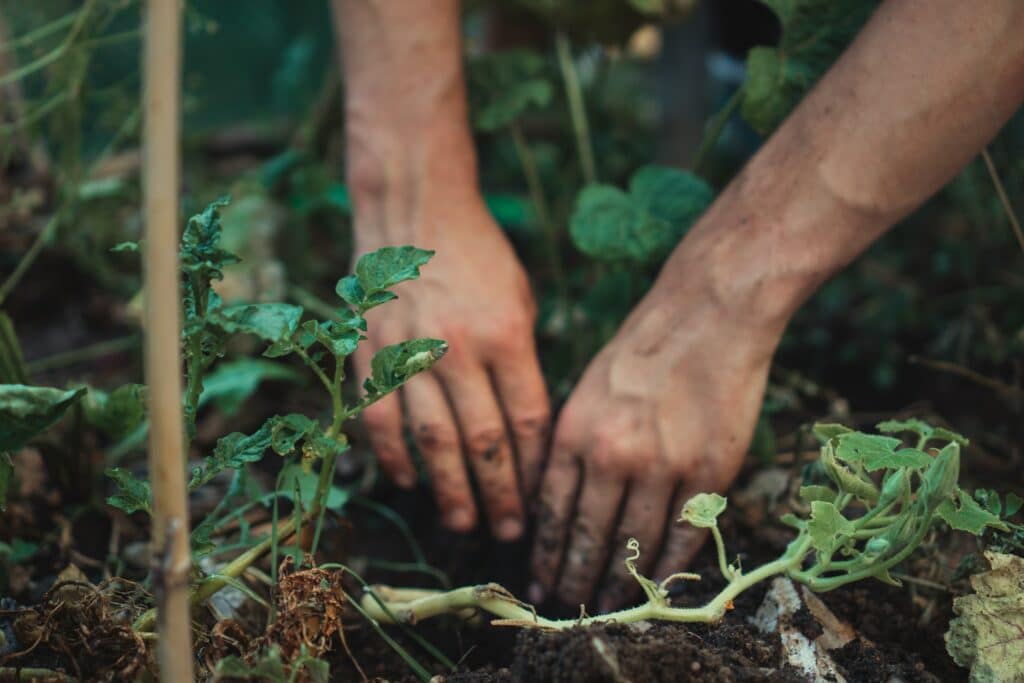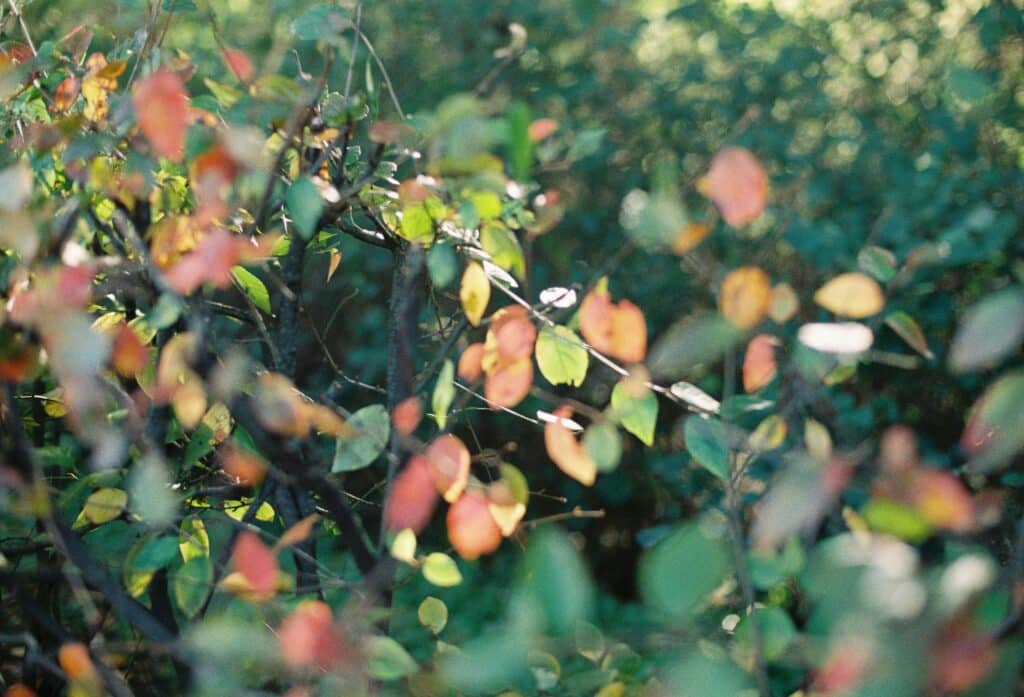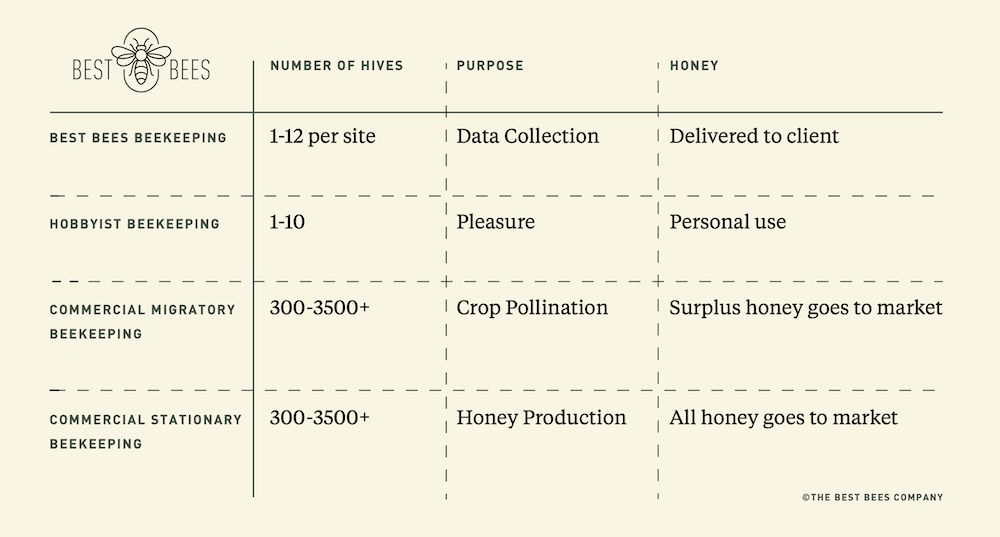Contents:
- What Are Pesticides?
- Types of Pesticides – What’s the Difference?
- How Pesticides Impact Bee and Pollinator Health
- Non-Pesticide Options to Combat Garden Pests
- Bee-Safe Pesticides
- Important Considerations if You are Using Pesticides In Your Garden
- Gardening Tips Continued: How to Prepare for Fall and Winter
- FAQs
What Are Pesticides?
When growing your own food, you’ve likely encountered a pest or two (or three) in your garden. Pests like red spider mites, aphids, tomato moths, and more can wreak havoc on the plants that you’ve worked so hard to take care of–and the thought of having to rip up your garden and start over can be incredibly frustrating!
— A pollinator garden is a green space specifically intended to provide pollinators with habitat. Best Bees Pollinator Habitat Gardens are custom-designed based on scientific insight into your environment’s biodiversity needs and pollinator preferences. —
In order to control garden pests like these, farmers and gardeners will often turn to the use of pesticides–but what exactly is a pesticide? For starters, “pesticide” is an umbrella term that refers to any substance used for preventing, destroying, repelling, or mitigating any pest — including insects, fungi, and weeds.
Types of Pesticides – What’s the Difference?
Under the umbrella of the term “pesticide,” there are several specific types used by gardeners and farmers alike:
- Insecticides: According to the Environmental Protection Agency, insecticides are chemicals used to control insects by killing them or preventing them from destructive behaviors on plants. Common insecticides include Organochlorine, Organophosphate, and Organosulfur. Each of these chemicals act on the insect’s nervous system, aside from Organosulfur, which kills the egg state of insects and is known as a growth regulator.
- Herbicides: Commonly used by people who grow crops, an herbicide is a pesticide that removes the presence of unwanted weeds. UPL notes that the presence of these “weeds” can negatively impact the growth and yield of various crops, since they also require water, sunlight, and nutrients to survive. There are two types of herbicides based on the method of application: soil-applied herbicides and foliar-applied herbicides (the latter is applied to the leaves).
- Rodenticides: This is commonly referred to as “rat poison”, although it is made to kill mice, squirrels, chipmunks, beavers, and other rodents that can damage crops or transmit diseases. All rodenticides can be toxic when eaten (and can even be toxic when inhaled or when it comes into contact with skin), and should never be used or stored within the reach of pets or children. According to the National Pesticide Information Center, many rodenticides stop normal blood clotting which can lead to internal bleeding and are referred to as anticoagulants.
- Fungicides: About 70-80% of crop losses are due to microbial diseases caused by fungi. Fungicide is a specific type of pesticide that is used to kill or prevent the growth of fungi and their spores, which helps prevent foliar diseases on a wide range of fruits, vegetables, fruit, and other crops.
How Pesticides Impact Bee and Pollinator Health
Even though about one billion pounds of pesticides are used each year in the United States to control pests and weeds– it’s incredibly important to understand the impact of pesticide use on bees and other pollinators. According to the Xerces Society, the effects of pesticides on pollinators include “removing important floral resources, causing subtle yet concerning effects on reproduction, navigation and memory, and high-profile incidents when pesticides kill bees.” But that’s not all – unfortunately, more than 90% of pollen samples from bee hives are already contaminated with more than one pesticide.
Pesticides have a multitude of effects on honey bees, both at the individual and colony levels. First, there are lethal effects. Since many pesticides are acutely toxic to bees, exposure often results in death. Insecticides like Organophosphates, Carbamates, Pyrethroids, Insect Growth Regulators and Neonicotinoids are highly toxic to bees.
Second, there are sublethal effects. This is from exposure to pesticides that do not outright kill the bees, but still have extreme effects on the overall performance of the colony. Exposure can inhibit honey bees at the individual level by reducing olfactory learning, reducing foraging behaviors, and even affecting reproduction in queens and drones.
Also, exposure to pesticides, particularly glyphosate-based herbicides, has also been correlated with impacting the microbiome of honey bees. When the honey bee gut biome is unbalanced, it impacts the health of the honey bee as a whole. These chemicals also weaken honey bees’ immune system, leaving them more susceptible to pests and pathogens. There is growing evidence that exposure to pesticides is making honey bees increasingly susceptible to pathogens like Nosema sp.This has detrimental effects to the colony and colony survival.
Third, there are synergistic effects. Since bees are rarely ever exposed to just one type of pesticide, there are synergistic effects when honey bees are exposed to multiple chemicals in occurrence with each other. Pesticides, insecticides, herbicides, etc all have individual toxicity levels, and when honey bees are exposed to more than one at the same time, the overall toxicity level is increased. Bees are often exposed to “chemical cocktails” – a result of mixing pesticides in tanks before being sprayed on crops. Pesticides like fungicides mixed with pyrethroid insecticides, and even miticides to treat Varroa mites, are all occurring in the same environment. Research is working towards better understanding how these chemicals interact with one another and how their combined occurrences are hurting honey bees.
Lastly, the use of herbicides reduces the availability of resources for honey bees to forage on. Many of the plants that people deem as “weeds” are actually important floral resources for pollinators and many are even beneficial to humans when used in herbalism.
Non-Pesticide Options to Combat Garden Pests
At Best Bees, we always strive to be proactive when it comes to pests, and Lead Horticulturist Renee Gervais has been taking this approach ever since she was introduced to growing food in her backyard as a child. Today, Renee is the owner of Gardens By Renee, an edible landscape and gardening business, where she teaches others how to grow their own food. Renee is also the Lead Horticulturist for the Best Bees Company, which allows her to combine her love of sustainable agriculture and pollinators.
“I don’t think you can successfully have a kitchen garden without having your bees and I don’t think that you can successfully have your bees without having the habitat in which they can forage for pollen and nectar. We have to have a little bit of it all.”
When it comes to the use of pesticides, Renee advocates for education about integrated pest management and a proactive mindset. In order to control pests in your garden without applying pesticides, here’s what she recommends:
- Connect with your garden and get to know it. Go out for five to ten minutes each day to see what’s happening with your plants and the visitors you might have.
- Try to make sure that you’re highly aware of what you’re planting and where you’re planting it. By not understanding the best places to plant, you might encounter a weak seedling that will be prone to pests. Instead, start with healthy quality plants by growing your own or by getting your seedlings from a reputable source – as always, be careful and cautious of the chemicals that might be present in the plants you purchase from large stores.
- Begin scouting for insects and pests before you have a major problem, and handpick them out of your garden. For example, squash bugs will lay small orange eggs in a row on the underside of leaves or stems. If you don’t wipe these away or handpick them, you’ll likely see hundreds more in the coming days.
- Don’t be weary of all pests, and allow some of your plants to bring beneficial insects in to be your allies. For example, one common pest is the tomato hornworm. If you see one of these with white bumps on its back, that’s an indication that your pollinator friend, the braconid wasp, is doing its job!
“If you really want to be an organic gardener, you need to be a part of your garden.” – Renee Gervais
Bee-Safe Pesticides
In a perfect world, we wouldn’t use pesticides at all, but that’s not the reality we live in. Emily O’Neil, staff scientist at The Best Bees Company, encourages people to use organic chemicals, like vinegar, or alternative methods, such as Integrated Pest Management strategies.
Some pesticide alternatives include:
- Neem Oil: Highly effective at repelling a variety of pests such as mites and aphids, as well as certain fungal diseases like powdery mildew, organic neem oil, when used at correct doses, will pose no threat to people or pollinators.Unlike chemical pesticides, neem is biodegradable, breaks down quickly, and leaves no lasting residue. Neem oil is powerful, so be sure that your homemade solution is properly diluted- it should include no more than 3% oil.
- Epsom Salt: A staple of any organic garden, Epsom salt is completely safe, non-toxic, and bee-friendly.In addition to being a magnesium-rich fertilizer for tomato and pepper plants, Epsom salts are also an effective way of keeping slimy critters like slugs and snails off your plants. Sprinkle salt around the base of affected plants, or apply a half-water, half-salt saline spray to the leaves of plants affected by other pests, like beetles.
- Castile Soap: Given its much-lauded gentleness and non-toxicity, it might come as a surprise that castile liquid soap is a potent pesticide. Its effectiveness stems from the fatty acids present in the olive oil-based soap, so be sure to use the real deal; dish soaps and detergents will be both ineffective and harmful here. Mix up a solution with only about 2% soap, and feel free to add a little cooking oil, vinegar, neem oil, or pepper to the mix.
- Essential Oils: An important component of many natural insect repellents intended for bodily use, eucalyptus oil is also an effective method of keeping harmful bugs away from your garden. Strong, pungent smells are what works here. Other essential oils to use include orange, peppermint, and rosemary. Sprinkle a few drops around the area, or add them to a spray bottle full of water, and apply directly to your plants.
If pesticides are unavoidable, there are ways to minimize their negative impact.
The EPA classifies the acute toxicity of pesticides into three categories: “highly toxic,” “moderately toxic,” and “practically non-toxic” based on their LD50 values. The term LD50 refers to an estimate of the amount of poison that will be a lethal dose to 50% of animals of a particular species. Choose the pesticides with the lowest toxicity rating if you must use them.
Additionally, there are some best practices for applying pesticides and other lawn-care chemicals that minimize the harm to pollinators.
- Don’t spray during the bloom – spray before or after the flowers have blossomed.
- Apply during a time when the bees are not as active, such as very early in the morning or late at night.
- Don’t apply the pesticide if bees are actively flying around and pollinating the plants.
- Apply the pesticide in a way that minimizes drift. Pesticide drift is the airborne movement of pesticides from the area of application to any unintended location. Avoid spraying before storms or rainy days, spray during calm, not-windy days, and don’t spray when there’s fog hanging in the air.
Make sure you carefully read the instructions of your pesticide of choice. They may prohibit applications under certain weather conditions, using high-pressure sprays, or using certain nozzles. Finally, always try to apply the smallest amount you feel you can get away with!
Important Considerations if You are Using Pesticides In Your Garden
The reality is that it would be irresponsible for us to tell every single person that pesticides should never be used. It’s estimated that approximately 1.8 billion people worldwide engage in agricultural practices – and for many of these people, having a successful crop season is the deciding factor in whether they have food on the table for their families or not.
While we will always advocate for a proactive approach to controlling pests, there may be instances where you believe that applying a pesticide is necessary for saving your plants. If you are thinking of applying pesticides to your garden, here are a few considerations that Renee urges you to consider:
- Be mindful of when you’re applying pesticides. Ideally, take a visit to your garden in the early morning to evaluate the situation. Renee notes that many people tend to their gardens in the middle of the day, but this is actually not ideal. Instead, opt to apply pesticides and tend to your garden in the early morning or later in the evening.
- Do not apply pesticides if you see pollinators like honey bees out gathering pollen and nectar. Continue checking in on your garden and wait until the activity of bees has slowed or stopped.
- Do not apply pesticides when the wind is blowing. According to research from The University of Nebraska, these chemicals should not be applied when the wind is blowing toward a nearby susceptible crop, a crop in a vulnerable stage of growth, or near sensitive areas like a beehive.
Gardening Tips Continued: How to Prepare for Fall and Winter
During this time of year, there are other things that gardeners should be aware of beyond the pests that can infiltrate your plants. In the fall and winter, Renee encourages gardeners to allow their space to thrive naturally–and to resist the urge to strip the earth of plants or rake your leaves during this changing season.
By raking leaves and having a perfectly manicured landscape, you might be removing important habitats for pollinators like butterflies, who depend on hollow trees, log piles, and loose bark for hibernation spots. However, one thing that can be cleaned up at this time of year is any rotten fruit that might have fallen to the ground.
Renee notes that fall is a fantastic time to take a test of the soil in your garden to see the percentage of organic matter you have and to help you optimize your growing space!
FAQs
Q: What do pesticides do?
A: Pesticides are chemical compounds that, when applied to plants, help destroy or kill pests like insects, rodents, or even fungi.
Q: Are pesticides harmful to bees and pollinators?
A: Depending on the type of pesticide that is applied, it can be very harmful to bees and pollinators. There are varying levels of pesticide toxicity, but even the lowest level still can be harmful to pollinators.
Q: What is integrated pest management?
A: Integrated pest management involves a proactive and preventative approach to controlling pests through a variety of techniques.


